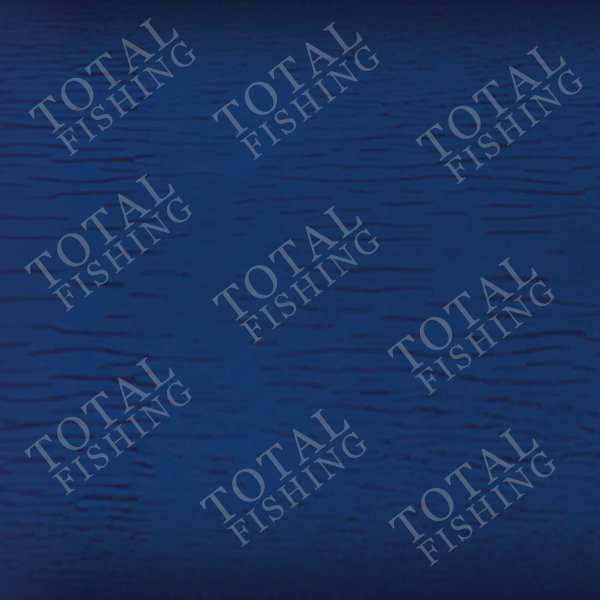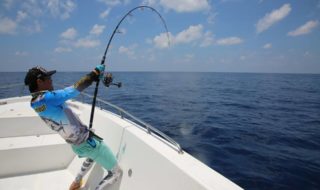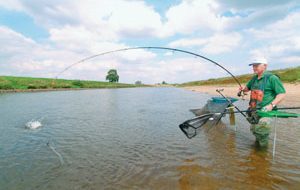MOST UK anglers coming over to the Emerald Isle for the weekend never make it out of Wexford, writes Kieran Hanrhan of www.sea-angling-ireland.org .
Wexford certainly has excellent shore marks on both the south and east coasts, and arguably even better pubs!
But if you are looking for bass rather than flatfish, then Waterford is arguably better and that extra hour in the car will be worthwhile.
This southern county has marks that can be fished regardless of the weather and the prevailing wind direction.
Tramore is Ireland’s answer to Blackpool, a massive shallow and safe strand fronting a traditional seaside resort. In spring the beach is empty and the waves are crashing green under scudding clouds and troubled skies.
Tramore is all about bass. People rarely fish Tramore for any other reason, although there is much more to the mark than that.
What makes Tramore almost perfect as a base is the accommodation, as it has excellent restaurants and pubs, a range of fishing and availability of free bait in abundance on your doorstep on the Back Strand.
There are a couple of well-stocked tackle shops just 15 minutes away in Waterford City, and you can explore the marks around Tramore itself, and the seashore east and west. There are coves to the west in particular that scream bass that are never ever fished. It is virgin territory.
The Westtown Rocks
For the shore angler there are six main marks around Tramore. To start with, drive or walk through the town to find the ‘cliff’ road, left after an orange thatched cottage (you can’t miss it!), and follow this winding seaside road out to the Westtown Rocks.
This old, concrete bathing station is still in use today, so it is prohibited to fish there, but rock platforms on either side offer good and safe shore angling. There is a nice car park beside the bathing station/gardens. In summer pollack and mackerel fall victims to feathers, typically at dusk, with coalfish and whiting replacing them in the winter months.
The codling have been scarce all along the south coast so far this year, probably due to the very mild winter. Strap conger are year-long residents, and the sand offshore, no more than ten metres out, does provide the odd plaice or dab.
John Diamond reports that when out snorkelling he encountered a large shoal of grey mullet rummaging around in the shingle and sand. Ground baiting could concentrate them for you.
In warmer weather, under your feet you find plenty of wrasse to 3lb, although the few I have caught were small, perhaps half that on average.
The shoreline wrasse offer great and unending sport, especially on light tackle. The best bait for me was fresh lugworm, whipped onto 1/0 Aberdeen patterns with shirring elastic. Mussels and clams work too – wrasse are not picky.
Whilst float fishing is possible, a simple paternoster with one or two hooks on short blood loops above a rotten bottom link is a simple but effective rig. There is no significant depth of water here except at high tide at which time you might use a French boom to locate the feeding depth.
Brownstone Head
If you fancy tussling with big wrasse, drive around the bay to Brownstone Head and a short trek across farmland will put you into very big wrasse country.
Between the bathing car park and the town itself, there is a small harbour and slipway, which can be used by boat anglers, but it very tidal and the sand can be very soft if launching at low tide. Furthermore the channel is quite narrow!
Tucked away behind the town is a mark known locally as the slipway. It produces bass in daylight, albeit as with all venues in Tramore, you need decent surf pounding the foreshore and darkness will add greatly to your chances. It hunkers in behind the new apartments and the end of the cliffs and is a quiet spot.
The Beach
The beach in Tramore is a real beast – over four kilometres in length. It is very shallow and very windswept. It is a hell of a walk fully laden and worse against the wind on the way back – most people walk behind the barrier and then pop over the top when they get to their preferred peg! Usually the wind is onshore.
The main beach is massive, shallow and featureless. You need a decent swell to get the bass quartering it. Tradition has it that you must cast just beyond the third breaker. Fair enough but anyone fly-fishing for them will work the water tables between the breakers, not past them. Can bass count? How many times have you caught fish on a short mis-cast?
On a beach this big you could use a swimfeeder stuffed with cotton wool soaked in pilchard or other fish oils, but only if the current and breakers are not too severe…
In winter the bass can be picky eaters and I have started using fluorocarbon for the snoods, although it is too early to tell if the investment is worthwhile.
I prefer big baits on a minimum of 4/0s when hunting bass, as it stops nuisance hook-ups from flounder and it survives the crabs for at least five minutes!
On the main beach try the hotspot called ‘the white pole’, which is opposite, yes you guessed it, a white pole.
Every year without fail Tramore gives up bass over the magical 10lb mark, but you have to be both patient and lucky. Baits tend to be lugworm and ragworm but try sandeels and peeler crabs, all available for collection at low tide on the Back Strand. I have given up on the tackle shops in Waterford City – they never seem to have any peeler crabs and yet their peers in Wexford always have them, so pick some up on the way.
There are some excellent marks (and pubs!) in Wexford so try not to get waylaid! Alternatively try collecting peelers in the rocks inland from the final mark called Saleens; just be careful with the tides. Crab tempts fish when everything else fails, and there are decent flatfish available in Tramore.
Perhaps because of the massive holiday throngs, I have never heard of rays being taken in Tramore, but on a calm summer night, it might be worth a cast.
Thankfully sea anglers have now taken to catch and release and the byelaws here are protecting the bass fishery. There is a maximum daily bag of two fish per angler and no fishing is allowed between May 15th and June 15th, the main spawning period. The minimum size is 40cms, which is more than one foot long, and thus slightly longer than the limit typically used in southern England.
Right at the end of the main beach, there is a mountainous range of big sand dunes, and directly in front of them, vying with the channel to the Back Strand, there are some surprisingly deep gullies carved into this harsh shore. Having assessed them at low tide, I think they are definitely worth a session, as bass would undoubtedly hold up in them or patrol up them on an incoming tide.
We know that a large population of bass always holds station at the channel’s mouth. Two lads in a Warrior boat could see what had to be bass on the fish finder but could not tempt a bite. Their spinners were not getting any response. What they needed was a fresh sand eel on a long flowing trace…
The Back Strand
Behind the seaside beach, behind the car park, there is The Back Strand. Most anglers dismiss it as the bait collection area only, and it does abound in lugworm, ragworm, clams, and in season sand eels in the channels. The best option is to park behind the main beach and follow the boundary of the municipal dump. From the point, follow the marks out into the mud out to the digging grounds. The worms are never huge, but rag and lug fall from every clod of oozy muck. Dig close to the channels.
Clams are found there and are excellent bait. Smash them up, pick off the shell and whip them on with shirring elastic.Two local anglers, digging bait for a competition, referred me to the low causeway that almost bisects the Back Strand. There is a big pool there, in between the walls. Mention was made of it being “twenty foot deep” which it certainly doesn’t look, and they say it is fairly stuffed with flounders.
The Saleens
Next, we come to The Saleens, probably the most famous location and for good reason. Get onto the R685 back road to Dunmore East, as this mark is approached from the far bank of the channel at the end of the main beach. The first right after a pub and the only signpost winds down to a small car park. A ten-minute walk towards the sea is required.
The sea flushes through this channel to the Back Strand lagoon. The water beside it was jumping with several species of sprat, which really surprised me.
Outside of high and low water, the current is ferocious, it swept away 175 gram (six ounce) grip leads. The weed, current and debris made bottom fishing impossible, but if you are feeling very lucky, peeler crab and sand eel are the key baits.
I would almost be tempted to try to floatfish it with a sandeel. Local anglers use any silver spinners but especially white Eddystone eel plugs to catch the bass, mostly after dark. The Saleens produces fish with amazing regularity. On a raw day I blanked and a sea trout jumped around me, adding to my frustration.
Over the week, talking to some local sea anglers, I got the impression that this year had been poor enough, and yet black bream in Wexford and a gilthead bream in Cork Harbour suggest warming waters and that will help the bass population. Since Ireland is at the northernmost limit of its range, every effort should be made to obey the existing laws and ensure its further development.
Fenor
If you are just totally out of luck, drive past the Westtown rocks and head for the village of Fenor. Just short of it, a small well signposted road leads you down to Kilfarassy Strand.
It is a lovely cove, with a small stream, and an island offshore so you can’t mistake it for anywhere else. Kilfarassy offers flounder by the bucket load and possibly a bass off the beach. Try just in front of the stream. If the watercourse is in spate, cast to either side or beyond it as dirty water can stop fish feeding, especially the flatfish. Coalfish, whiting and codling can be taken either further out or nearer the encircling rocky arms at either end of the cove.
It is mixed to foul ground here so pulley rigs with rotten bottoms are your best option. Wrasse, dogfish and conger are possible and in summer you can try for thornback rays. Lugworm is good bait but a peeler crab will appeal to the bass, not that other fish will turn their noses up at it…
And if that doesn’t work, all is not lost. If you still manage to blank, head back to Tramore and console yourself with fresh cod and chips from the traditional chippie huddled amongst the vacant amusement stands. Tramore is thronged in summer with families and holidaymakers so take an early spring break…
How to get there: Maybe two hours from Rosslare Car Ferry Terminal, on the N25 road to Cork, and just past Waterford City, turn left onto the R675 for Tramore.
For more information on these shore marks and all the others including data on species, rigs and baits, check the listings on www.sea-angling-ireland.org.






